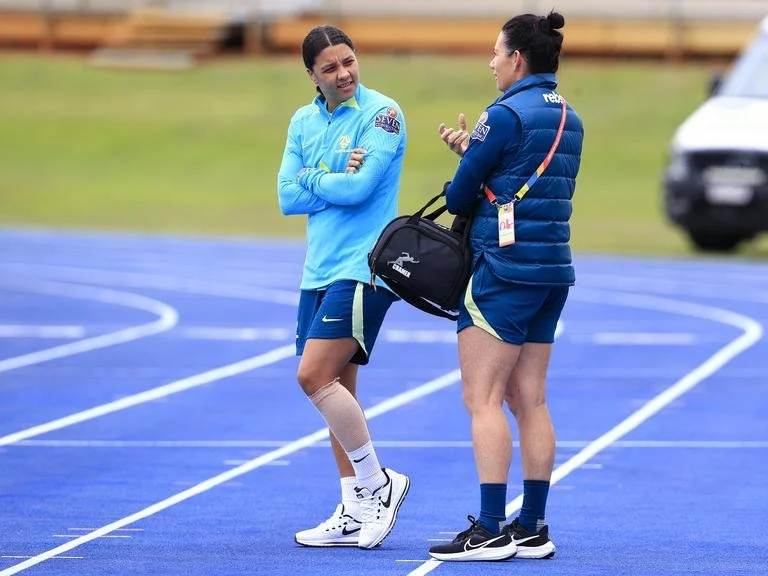Why did it take so long for Sam Kerr’s calf to get ready for the FIFA Women's World Cup?
Sam Kerr had been ruled out for the majority of the FIFA Women’s World Cup Tournament due to her calf injury. She only managed to start the bench at the 80th minute against Denmark, played 35 minutes against France and only managed to start the semi-final game against England, 4 weeks after the initial day of injury (20th July). UPG Physiotherapist Jason take a deep dive into the calf muscle and break down what really went down with Sam.
Let's begin by understanding what the calf is…
The calf is mostly made up of 2 separate muscles, gastrocnemius (gastroc) and soleus. The gastrconemius muscle is the “powerhouse” of the calf; it generates explosive force to propel us running. Where the soleus muscle is a flat muscle which helps generate sustained forces during longer runs. When the gastroc is injured, pain is felt more suddenly and most people will describe it as like “being shot in the leg”. But a soleus strain, pain builds gradually and generally more diffused and somewhat like a cramp.
Understanding the calf injury risk and its nature
Among elite soccer athletes, the prevalence of a calf injury is about 6%. Older age and a history of previous calf injury are related to higher risk of this injury. The chance of a re-injury is also quite high, 15%. Especially higher with age again, recent history of ankle injury and involvement of soleus muscle. The extent of the injury can be diagnosed with clinical testing, with a range below:
10 days to 3 weeks recovery - Myofascial injury - pain in stretching the muscle and loss of range of motion
4- 8 weeks - Muscle/ tendon injury - pain in using and stretching the muscle
2 months and more -Tendon injury - pain in walking and limping
The recovery tends to be long if an MRI shows a deeper muscle injury and if the mechanism of injury is related to running.
So, looking at everything mentioned, the fact that Sam needed four weeks to resume full-capacity 90-minute play strongly indicates the likelihood of her having encountered a low-grade muscle injury.
What are the steps involved in recovering from this type of injury?
Based on a study conducted in 2022 with insights and results from a panel of skilled clinicians, specialising in elite sports and relevant research has identified six distinct rehabilitation phases in the recovery process.
Early loading - early movement as tolerated, isometrics, lower reps/load or restricted range
Loaded strengthening - strength work through the range, and soleus work is important regardless of the type of injury
Power and plyometric development - demands in direction, intensity, duration, and external loading. Small-length excursions like pogos; large-length excursions like forward hopping
Locomotion and preparation for sport - walking/ marches, skips. Then a graded return to running
Return to play - guided by exposure and response to sports-specific activities. Testing sprinting, change of direction
Athlete monitoring - high rate of recurrence, recommend follow up at least 2 months post return to sport.
The results showed a high emphasis on prevention and recognition of weaknesses.
It's important to note that while specific details about Sam's recovery process remain undisclosed, it's clear that her journey towards her calf muscle recovery followed a carefully paced approach. The recovery of her muscle required intermittent periods of rest and healing, which evidently contributed to her gradual and well-considered return to the matches,
So, if you're wondering how likely you are to end up with calf injuries? Here are a few tests you can try to that can give you an idea. These tests allow you to know your risk zone and get an idea of your situation.
Max calf raises - do as many calves raises as you can do having a metronome at 60 bpm, compare it to the other side. The normal value for a female in her 20s is 30 reps.
Side hop test - see how strong your ankle stability and calf strength are by hopping side to side 40cm apart for 30secs. Aim to have both sides quite similar. The benchmark for a 21-year-old male is 55-60 reps
If you're aiming to strengthen your calves as a preventive measure against injuries, here is a set of exercises with a video for you:
Wall Squat Calf Raises: This one's all about giving your soleus a workout. Get against a wall, squat down a bit, and then rise up onto your toes. Feel the burn!
Wall Calf Plyometrics: Looking for some explosiveness? This exercise has your back. Push off the wall with your calves, using that power to lift yourself off the ground slightly. It's like calf fireworks!
https://photos.app.goo.gl/k9ts3qyHBYpy39jG7
References
Featured Image: Adam Head - Source: News Corp Australia Injured Matildas skipper Sam Kerr (left) chats to a team medico at training.
Green B, McClelland JA, Semciw AL, et al. (2022). The Assessment, Management and Prevention of Calf muscle Strain Injuries: A Qualitative Study of Practices and Perspectives of 20 Expert Sports Clinicians. Sports Med Open. 8(10), 10.
Green B, LinM, McClelland JA wt al. (2020). Return to Play and Recurrence After Calf Muscle Strain Injuries in Elite Australian Football Players. AJSM.


